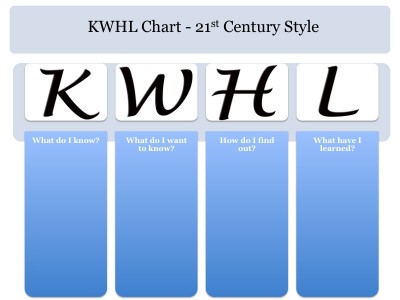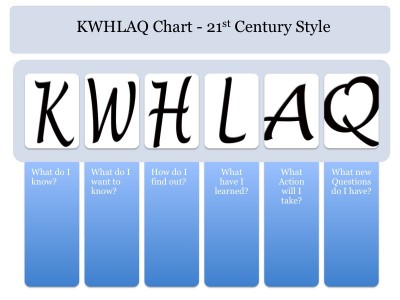Upgrade your KWL Chart to the 21st Century

One of the take aways from the Curriculum Mapping Institute this past week was that it brought an upgrade to THE trusted KWL (Know, What to Know and Learned) Chart to the forefront. It seems a no brainer…one of those things… “I should have thought about it”… So what is this upgrade all about?
An “H” snuck into the Acronym!
- What does this “H” stand for”?
- Why is this an upgrade for the 21st century?
I started out by searching Google, which immediately wanted to correct my search term and showed me the traditional “KWL chart” results. I had to re-affirm that I indeed wanted to find out more about KWHL charts. (The nerve…!)

The top search results turned out mostly downloadable files for templates, which was quiet interesting as there were several explanations in these tutorials what the “H” could stand for:
- HOW can we find the answers to these questions?
- HOW can we find out what we want to learn?
- HOW did the learning take place?
- HOW can we learn more?
- HOW will we find the information?
In direct relation to our quest to bring Information literacy in the 21st century to our teachers and students, the “HOW will we find the information” sticks out right away for me. A chart, that points out “knowing HOW to get to information”, which highlights essential skills in the Information age, seems of vital importance when planning lessons and units as well as teaching the process to our students.
My Twitter network was much better in helping me extend my search for KWHL. The tweet from my friend Chic Foote from New Zealand even revealed a further extension by including “AQ” to the mix: Apply and Question.
OK, so we have doubled the length of the original acronym. We have a total of three new sections in the famous chart.
Tools and ideas to transform education. Sign up below.


The search for “KWHLAQ” immediately took me to Maggie Hos-McGrane from Switzerland (How could I have not ended up at her excellent blog Tech Transformation? ) Maggie wrote a great explanation post about the letters that make up the Alphabet Soup- KWHLAQ. Maggie is putting the acronym in relationship to the PYP (IB Primary Years Programme) model at her school? She assigns the following explanation to the three “new” letters in the acronym

H – How will we find out the answers to our questions? Students need to think about what resources are available to help them find the answers.
A – What action will we take? This is another way of asking how students are applying what they have learned. Action is one of the 5 essential elements of the PYP and it is an expectation of the PYP that inquiry will lead to responsible action initiated by students as a result of the learning process.
Q – What new questions do we have? At the end of a unit of inquiry there should be time to reflect on whether we have successfully addressed our initial questions and whether we have come with with other questions. Actually, if the unit is successful I believe there should be more questions – we should not be “done” with learning.
As Maggie used the PYP model as the base for her rational of the expansion of the traditional KWL chart, I am looking at it through the 21st century skills and literacies lens.
H- HOW will we find the information to answer “What we want to know?”
Information Literacy is one of literacies educators and students seem to have the most trouble with. Not being able to find the information we need or having to wonder if the information is accurate often gets blamed on the OVERLOAD of information being produced and disseminated online, as well as the fact that ANYONE can contribute. We need to have the skills to be able to deal with the amount of information by learning how to filter that information through a variety of means. What better way to integrate the “H” into our learning inquiries in order to find, evaluate, analyze, organize, curate and remix information.
A- What ACTION will we take once we learned what we set out to learn?
There used to be a time… (when I was at school) that information was set in stone (well, it was written in black and white on paper, bound in a book). I could not really add my perspective or new information that I learned from my teacher, family, friends or from experience to the “book”. Issues that we learned about, where (mostly) far removed (time and geographically) from our reality. How could one student accomplish change beyond their immediate surroundings? How could one student affect change? The reality of feeling helpless beyond our neighborhood has changed. Tools to reach and collaborate with a worldwide audience are available and free to use. Making students aware of their power and the opportunities available to take action is imperative.
Q- What QUESTIONS do we have?
The “Q” immediately brought Bill Sheskey’s quote from the book Curriculum21 by Heidi Hayes Jacobs to mind.
Bill has summed up the upgrade of the KWL-chart for me. It is not about delivering the answers anymore. In the 21st century, being able to ask the questions (and continuing asking) is the skill we need to instill in our students. Learning is not confined to a textbook, the walls of a classroom or peers and experts who are physically in the same location. Learning is open ended…we strive to be life-long learners. Why would a chart end with the question “What have I learned?”. Let’s leave the chart open ended with “What (new) questions do I still have?

I have learned in the past that when planning with teachers in upgrading their units, chart templates have been a welcomed addition. It creates a manageable overview of what we need to consider as we strategically upgrade to the 21st century. Using templates also can show, over time, the different skills, literacies and roles to empower learners that have been touched upon. Templates such as these, when used consistently, can support teachers as they are struggling with 21st century fluency.
What are your thoughts on adding the “How to find the information?”,”What Action will you take?” and “What new Questions do you have?”? How do these additions relate to good practice in education for the 21st century?
How have you used KWL, KWHL or KWHLAQ charts in planning and/or with your students?


